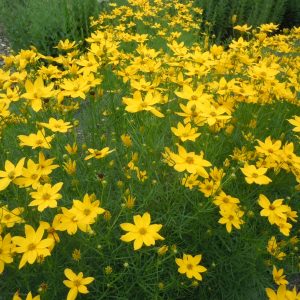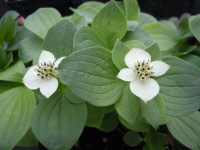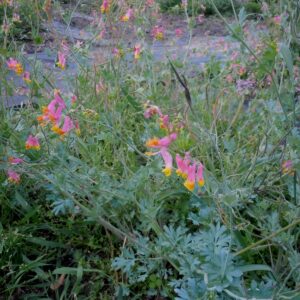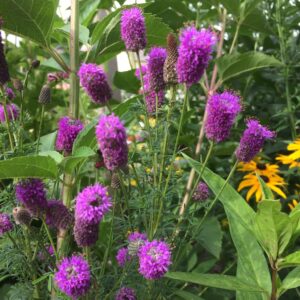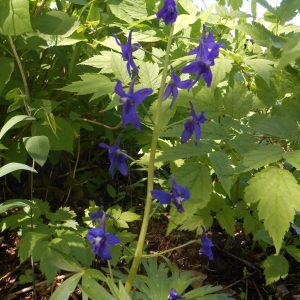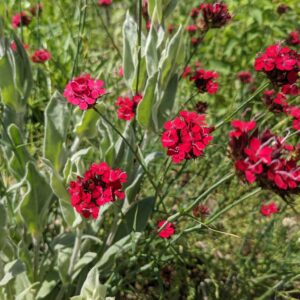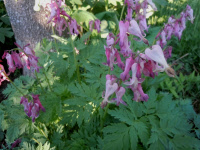Plants for Butterflies and Other Pollinators
Showing 57–64 of 211 results
-
Coreopsis verticillata Thread leafed tickseed Z 4-9
All summer into fall, free-blooming non-stop - yolk yellow daisies of 8 narrow spoon-shaped petals with a color matching center each atop a wiry stem. Cut back half-way to promote reblooming in fall.
All summer into fall, free-blooming non-stop – yolk yellow daisies of 8 narrow spoon-shaped petals with a color matching center each atop a wiry stem. Cut back half-way to promote reblooming in fall.
Size: 24" x 18" spreading
Care: Sun to part shade well-drained to moist well-drained soil, drought tolerant
Native: S.E. U.S.
Wildlife Value: attracts butterflies, Deer resistantNatives made a tea with the roots to remedy diarrhea and induce vomiting and a tea with the plant tops to make blood strong. A drink made from boiling the entire plant was used to remedy internal pain and bleeding. Also made a red dye and a yellow dye. Exported from its native America to England in 1759.
-
Cornus canadensis Bunchberry, Creeping dogwood Z 2-7Cornus canadensis syn. Chamaepericlymenum canadensis Bunchberry, Creeping dogwood Z 2-7
Four white, pointed petal-like bracts in spring and showy scarlet berries in fall
Four white, pointed petal-like bracts in spring and showy scarlet berries in fall
Size: 6” x spreading slowly
Care: part shade in moist, ACIDIC soil. Needs moisture to establish
Native: Northern areas from the east to the west coasts of No. America, Wisconsin native.
Wildlife Value: Host for the caterpillar of the Spring azure butterfly. Pollen and nectar for many bees, wasps, ants, butterflies and beetles. Deer and rabbit resistantFlowers open faster than any other flower, in less than ½ millisecond. Abnaki Indians used it to cure side pains. Algonquin made a cathartic tea, cured colds, and stomach aches with this. Delaware reduced body pains with it. Chippewa, Cree and Eskimo smoked the berries. Probably 1st collected for gardens by John Bartram (1699-1776). Offered for sale at his nursery near Philadelphia. Sent to Dr. Fothergill in London in 1774. “One of the prettiest plants for the bog garden or the cool parts of the rock garden.” William Robinson 1899. Pressed specimen in Emily Dickinson’s herbarium.
-
Corydalis sempervirens syn. Capnoides sempervirens, Fumitory, Rock harlequin RESEEDING SHORT-LIVED PERENNIAL
Pink tube-shaped flowers with flaring yellow ends bloom from spring to summer
RESEEDING SHORT-LIVED PERENNIAL
Pink tube-shaped flowers with flaring yellow ends bloom from spring to summer
Size: 10-12” x 10-12”
Care: Sun to part shade in moist well drained soil
Native: from Nova Scotia west to Alaska, south to North Carolina, Wisconsin nativeCorydalis is Greek for “lark” korydalos, referring to the shape of flower resembling a lark’s spur. First described and named (name now changed) in 1753. Pressed specimen in Emily Dickinson’s herbarium.
-
Cymbalaria muralis Kennilworth ivy, Pennywort Z 4-8
Tiny pink snapdragons all summer
Tiny pink snapdragons all summer
Size: 2-3” x spreading, trailing
Care: full sun to part shade in moist, well drained soil
Native: So. EuropeIntroduced to gardens by the early 1600’s. Southern Europeans ate the plant as a salad. Tournefort reported that it grew “on mud walls, old ruins and upon rocks” in Italy.
-
Dalea purpurea syn. Petalostemon purpurea Violet prairie clover Z 4-9
Vase shaped clump with wands of violet to purple encircling tall coneheads mid-summer
Vase shaped clump with wands of violet to purple encircling tall coneheads mid-summer
Size: 2’ x 18”
Care: full sun in well-drained to moist well-drained soil.
Native: Canada to Texas, Wisconsin native
Wildlife Value: Host for caterpillars of Dogface Sulphur, Striped blue & Mexican blue butterflies. Supports over 80 bee species including endangered Rusty patched Bumble BeesDalea named to honor English botanist Dr. Samuel Dale (1659- 1739.) Chippewa, Meskwaki and Navajo used medicinally – as remedies for heart ailments, pneumonia, diarrhea and measles. Comanche and Lakota chewed the root like gum, for its sweet taste. Sioux combined it with Amorpha canescens, Leadplant to ambush bison. Sioux also treated fevers and stomach disorders with an infusion made from the plant. Pawnee made brooms from the flexible stems. 1st collected by French botanist André Michaux (1746-1802) who spent 11 years in America collecting hundreds of new plants.
-
Delphinium tricorne Dwarf larkspur, Spring larkspur Z 4-8
Spring ephemeral of blue delphinium elf-cap spikes. Substitute these for tulips, a favorite food of deer and rabbits
OUT OF STOCK – Available to order in Spring only
Spring ephemeral of blue delphinium elf-cap spikes. Substitute these for tulips, a favorite food of deer and rabbits
Size: 18-24” x 6-9”
Care: sun to shade in moist well-drained to moist soil
Native: Pennsylvania to Iowa, south to Alabama and Oklahoma and states in between
Wildlife Value: food for hummingbirds and butterflies; deer & rabbit resistant.Collected by André Michaux c. 1800. Cherokee used this for heart ailments and reported that it makes cows intoxicated and they die. The name tricorne comes from the 3-cornered shape of its seeds, like the shape of colonial hats with brims turned up on three sides. This is breathtakingly beautiful but slow to grow. It is also an ephemeral and dies back after going to seed so mark it or have a good memory where it is so you don’t dig into it planting something else. It comes back in spring.
-
Dianthus cruentus Blood pink Z 5-9
Small but eye-catching carmine flowers held high on a leafless stem above basal foliage. Blooms in late spring-early summer
Small but eye-catching carmine flowers held high on a leafless stem above basal foliage. Blooms in late spring-early summer
Size: 2-3’ x 6-9”
Care: sun in moist well-drained soil
Native: Balkans
Wildlife Value: Attracts bees & butterfliesFirst described in Spic. Fl. Rumel. 1: 186 1843.
-
Dicentra eximia syn Lamprocapnos , Fringed bleeding heart Z 4-8
May to October, dangling rose pink heart-shaped panicles
OUT OF STOCK
May to October dangling rose pink heart-shaped panicles among fern-like, grey-green foliage. They appear delicate but are not.
Size: 8” x 8”
Care: Part shade, moist to moist well-drained soil
Native: Mountains from New York to Georgia
Wildlife Value: Nectar source for hummingbirds & White swallowtail butterfly.Dicentra derived from Greek dis meaning two and kentros meaning spurs. Introduced to gardens by Quaker planthunter and nurseryman John Bartram (1699-1777) in mid-1700’s. Recommended by Gertrude Jekyll, mother of mixed perennial borders, in 1908.
**LISTED AS OUT OF STOCK BECAUSE WE DO NOT SHIP THIS ITEM. IT IS AVAILABLE FOR PURCHASE AT OUR RETAIL LOCATION.

